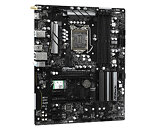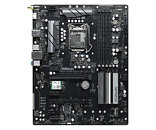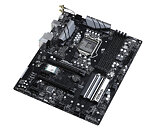Friday, May 1st 2020

ASRock Z490 Phantom Gaming 4SR First ATX12VO Motherboard in the DIY-channel
The winds of change are beginning. The ATX12VO PC power-supply standard, earlier thought to be an OEM-mainstay with later introduction in the DIY retail channel, has already reached it. The ASRock Z490 Phantom Gaming 4SR is the first board. Gone is the 24-pin ATX power connector, a smaller 5-pin pure-12 V input takes its place. A 6-pin PCIe connector takes in additional 12 V input. The 8-pin EPS connector (another pure-12 V input) is right where it should be, near the CPU VRM area. There are two small 4-pin connectors, which could be 5 V and 3.3 V outputs from the motherboard, to SATA power connectors.
The part of the PCB next to the memory area is bustling with a few more power phases than vDIMM. These convert 12 V to 5 V and 3.3 V (essentially what a PSU with DC-to-DC switching does). The rest of the board's I/O feature-set is fairly standard: four SATA ports, a single M.2-22110 slot, an M.2 E-Key slot holding an 802.11ac WLAN card, 6-channel audio, and 1 GbE wired networking driven by an Intel i219-V controller. The company didn't reveal pricing or availability.
Source:
madn3ss795 (Reddit)
The part of the PCB next to the memory area is bustling with a few more power phases than vDIMM. These convert 12 V to 5 V and 3.3 V (essentially what a PSU with DC-to-DC switching does). The rest of the board's I/O feature-set is fairly standard: four SATA ports, a single M.2-22110 slot, an M.2 E-Key slot holding an 802.11ac WLAN card, 6-channel audio, and 1 GbE wired networking driven by an Intel i219-V controller. The company didn't reveal pricing or availability.



40 Comments on ASRock Z490 Phantom Gaming 4SR First ATX12VO Motherboard in the DIY-channel
It seems like they wanted to test the waters, yet made a board no-one would really want to buy. Great way of proving to yourself that it won't sell...
Besides, this seeming only complicates the motherboard.. that's not the best of things when such crazy times are upon us again as 300w+ cpu power draws and 450$£€+ prices.
PSUs will cost less, as they become simpler to make and needs less wires, which is actually a big percentage of the cost.
www.techpowerup.com/263213/pure-12v-psu-standard-named-atx12vo-debuts-later-this-year
It makes no sense.
That said, we might very well see "hybrid" PSUs to start with, IF this new standard takes off.Sure, but why not at least add two M.2 slots for drives?
I can't find any 12VO power supplies out there - do they exist?
Apparently there are some coming.
www.techpowerup.com/263012/fsp-at-ces-2020-a-next-gen-pure-12v-psu-and-a-ups-that-wants-to-see-the-world
- Suddenly you've rendered useless billions of existing PSUs.
- You've moved some of power circuitry from the PSU to the motherboard and by doing that you've increased the mobo's complexity and fragility.
- You've made motherboards even more expensive than they were already.
- Replacing the PSU is easy while replacing/or RMA'ing the motherboard is extremely time consuming and costly.
And that's been done to increase their profits, not because they care about their users.Transitioning to a new PSU standard that still fits with the rest of the ecosystem is a very small transition in comparison.
DC-DC power conversion is a very simple thing these days and shouldn't cause any concerns whatsoever when it comes to the board life.
As I said above, about $1 in parts.
Again, why should be see more board failures from this? Please expand your reasoning on this.
Besides, this is going to be something that most likely takes a decade to transition to, as for the time, Intel isn't pushing this standard, they just put it out there as a common standard for the OEMs that feel that they want to make this transition. I can see this being a great standard in something like SFF systems and NAS appliances to start with. Once SATA has been move to the history books, this standard makes even more sense.
What I don't get on, this is a tech site, yet there are so many people here that seems to be against progress, just because. Technology will always progress, one way or another, if it wasn't, it wouldn't be called technology.
The cheapest $140, the most expensive $235.
Fast forward to 2020:
The cheapest is now $150 (not too much of a difference, albeit it's absolutely barebones) while the most expensive goes for $750 or even more since Maximum XII Extreme Glacial price hasn't been announced yet. Under the pretense of "improving" things for the customer they've raised the prices fourfold. Yes, I'm angry because in my country the average monthly wage is around $450 while first-country visitors of TPU appreciate everything brand new and cool because you can easily afford it which explains that so many of you are rocking 9900KS/3950X/2080 Ti's not because you need them but because you can. Shows how little you actually care about the people who are that well-off.Such systems could use their own power delivery standard - I welcome it. However now we are talking about bog standard ATX/mATX motherboards. And I'm sorry, I'm NOT happy about that.
The only drawback is that the mobos need to have good 5V stages for the modern USB devices and their charging.
And motherboard makers are very conservative with their ports. Hell even brand new 700$+ boards come with a PS/2 port still. And USB 2.0 ports. Atleast we got rid of PCI and DVI/VGA.
Stop the ranting and BS.
Thank You & Have a Sunshiny Day
I agree that having all this extra shit on a MB sucks as RMAing that sucks, but let's be honest, voltage reduction is trivial and cheap, and if that part fails, the rest of the MB didn't stand a chance anyway.
I already wish SATA would go away, and we'd get some sort of riser card to stuff full of M.2 drives. Won't stick off the board more than the width of a typical M.2 kinda thing.
It'd even make more sense to have a bunch of USB3/-C ports RIGHT on the board and stuff M.2 drives w/ adapters into the typical bays a 2.5"/3.5" drive would take up.
Move all the legacy SATA drives to your NAS/Server. I don't know anyone personally that fills their desktop up with SATA drives anymore. Maybe one or two tops for a local backup.